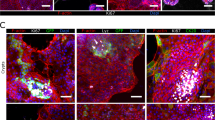Abstract
Purpose. To introduce confocal laser scanning microscopy (CLSM)combined with digital image restoration to characterise Caco-2 cellsunder different culture conditions, and thus to define additional validcriteria for the optimisation of culture models.
Methods. Growth curves were established and transepithelial electricalresistance (TEER) measured for cells grown in EMEM or DMEMmedium on Cyclopore™ membranes. Cytoskeleton, cell nuclei and tightjunctions (TJ) were investigated by CLSM.
Results. Cultures reached a plateau of ∼4.5 × 105 cells/cm2 after∼ 10 days. At the same time TEER reached 750 Ω cm2. An irregular,fairly complete network of TJ was present at confluence (∼2 d).Between 15 and 30 days a regular TJ network was established. Cellsformed mixed mono- and multilayers under most conditions with twoexceptions: flat monolayers were observed on polycarbonate filterswith EMEM and with the Biocoat™ intestinal epithelium differentiationenvironment system. In multilayers TJ were found in the upper aswell as in the lower cell layers although the regular vertical polaritywas disturbed.
Conclusions. CLSM represents an important tool to investigate thecytoarchitecture of Caco-2 cells. 3D-analysis of confocal data givesimportant clues on the characteristics of cell layers and thus helps tovalidate optimisation strategies.
Similar content being viewed by others
REFERENCES
K. L. Audus, R. L. Bartel, I. J. Hidalgo, and R. T. Borchardt. The use of cultured epithelial and endothelial cells for drug transport and metabolism studies. Pharm. Res. 7:435–451 (1990).
A. R. Hilgers, R. A. Conradi, and P. S. Burton. Caco-2 cell monolayers as a model for drug transport across the intestinal mucosa Pharm. Res. 7:902–910 (1990).
P. Artursson and J. Karlsson. Correlation between oral drug absorption in humans and apparent drug permeability coefficients in human intestinal epithelial Caco-2 cells. Biochem. Biophys. Res. Comm. 175:880–885 (1991).
W. Rubas, M. E, Cromwell, Z. Shahrokh, J. Villagran, T. N. Nguyen, M. Wellton, T. H. Nguyen, and R. J. Mrsny. Flux measurements across Caco-2 monolayers may predict transport in human large intestinal tissue. J. Pharm. Sci. 85:165–169 (1996).
J. D. Irvine, L. Takahashi, K. Lockhart, J. Cheong, J. W. Tolan, H. E. Selick, and J. R. Grove. MDCK (Madin-Darby canine kidney) cells: a tool for membrane permeability screening. J. Pharm. Sci. 88:28–33 (1999).
D. J. Brayden. Human intestinal epithelial cell monolayers as prescreen for oral drug delivery. Pharm. News 4:11–15 (1997).
P. Artursson and R. T. Borchardt. Intestinal drug absorption and metabolism in cell cultures: Caco-2 and beyond. Pharm. Res. 14:1655–1658 (1997).
B. Rothen-Rutishauser, S. D. Krämer, A. Braun, M. Günthert, and H. Wunderli-Allenspach. MDCK cell cultures as an epithelial in vitro model: cytoskeleton and tight junctions as indicators for the definition of age-related stages by confocal microscopy. Pharm. Res. 15:964–971 (1998).
S. Chong, S. A. Dando, and R. A. Morrison. Evaluation of Biocoat intestinal epithelium differentiation environment (3-day cultured Caco-2 cells) as an absorption screening model with improved productivity. Pharm. Res. 14:1835–1837 (1997).
H. T. M. van der Voort, and K. C. Strasters. Restoration of confocal images for quantitative image analysis. J. Microsc. 178:165–181 (1995).
M. Pinto, S. Robine-Leon, M.-D. Appay, M. Kedinger, N. Triadou, E. Dussaulx, B. Lacroix, P. Simon-Assmann, K. Haffen, J. Fogh, and A. L. Zweibaum. Enterocyte-like differentiation and polarisation of the human colon carcinoma cell line Caco-2 in culture. Biol. Cell 47:323–330 (1983).
W. J. Woods and D. Asa. Morphological comparison of Caco-2 cells in the BIOCOAT intestinal epithelial cell environment and the traditional 21-day Caco-2 culture system. Becton Dickinson, Technical Bulletin #426 (1997).
M. J. Briske-Anderson, J. W. Finley, and S. M. Newman. The influence of culture time and passage number on the morphological and physiological development of Caco-2 cells. Proc. Soc. Exp. Biol. Med. 214:248–257 (1997).
P. Anderle, E. Niederer, W. Rubas, C. Hilgendorf, H. Spahn-Langguth, H. Wunderli-Allenspach, H. P. Merkle, and P. Langguth. P-Glycoprotein (P-gp) mediated efflux in Caco-2 cell monolayers: the influence of culturing conditions and drug exposure on P-gp expression levels. J. Pharm. Sci. 87:757–762 (1998).
Author information
Authors and Affiliations
Rights and permissions
About this article
Cite this article
Rothen-Rutishauser, B., Braun, A., Günthert, M. et al. Formation of Multilayers in the Caco-2 Cell Culture Model: A Confocal Laser Scanning Microscopy Study. Pharm Res 17, 460–465 (2000). https://doi.org/10.1023/A:1007585105753
Issue Date:
DOI: https://doi.org/10.1023/A:1007585105753




